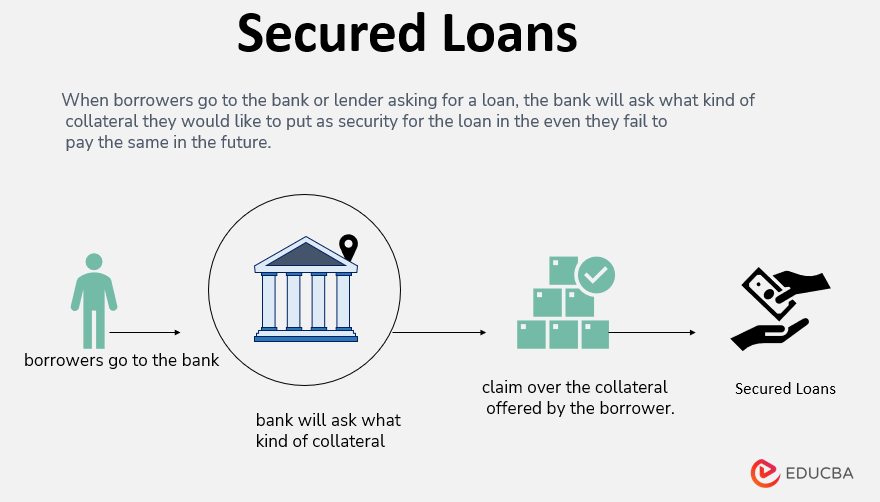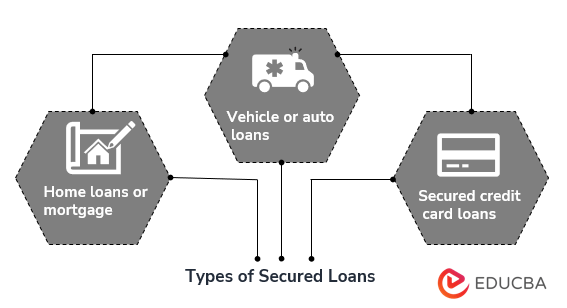Definition of Secured Loans
The loans backed up by some security or collateral assets of the borrower is known as secured loan. The concept behind secured loans is that the bank or other lender can use the collateral asset to recover the loan amount if the borrower fails to pay.
It also motivates borrowers to pay the loan within the expected timeline so they do not lose their collateral assets and can avoid repossession or foreclosure.
Explanation
When borrowers go to the bank or lender asking for a loan, the bank will ask what kind of collateral they would like to put as security for the loan in the event they fail to pay the same in the future. And in the future, if borrowers face trouble while paying the loan, the lender would put a lien, i.e., a legal claim over the collateral offered by the borrower.
The lender or bank has the claim over the borrower’s collateral until they do not repay the loan. When the loan is fully paid, the ownership is transferred from the lender to the borrower once again. And if borrowers default on the payment of their loans during the loan term, the lender can sell off the collateral to cover the losses incurred due to the non-payment of the loans.
Features of Secured Loans
Some of the Features are mentioned below:
- The borrower always pledges something as security or collateral for the secured loans.
- Secured loans are generally taken for more significant amounts.
- Secured loans are offered at a lower interest rate as the principal is secured due to collateral.
- The asset purchased with the loan amount is also collateral for the loan principle.
Example of Secured Loans
Let us take a straightforward and regular example where a borrower goes to the bank and asks for a loan to purchase a house and a car. The lender will ask for the house and car as collateral against the home and car loans. And in return lender promises to provide the loan at a lower interest rate than usual. The borrower will accept the offer, and the loan will be considered a secured loan due to the collateral that the borrower put up to secure or back up the loan.
Types of Secured Loans
Banks and other lenders offer various types of secured loans in the market. The major ones and most commonly used are discussed below:
- Home loans or mortgage: Home loans or mortgage tops the list of secured loans. In mortgage loans, borrowers put up their house property as collateral. And in case the borrower fails to pay the loan, the house property as collateral will go into foreclosure, and the borrower will lose the home.
- Vehicle or auto loans: As the name suggests, the borrowers put the vehicle purchased as collateral. Standard vehicle loans are auto loans, car loans, boats, bikes, and even airplanes. The procedure is the same as home loans, i.e., in case of non-payment, the lender will sell off the collateral to cover the losses incurred.
- Secured credit card loans: In this type of loan borrower has to put up cash deposits as collateral for the loans against the credit card. If the borrower cannot pay the monthly credit card bill in the future, the cash deposit can be applied against the same.
What Can be Used as Collateral for Secured Loans?
Borrowers put different kinds of assets as collateral; lenders generally prefer liquid assets, i.e., the assets that can be quickly sold off in the market. But any assets allowed per the land law can be put as collateral against the secured loans. Some of the assets that are commonly used as collateral are mentioned below:
- Home, house property, or real estate.
- Bank accounts, certificates of deposits, money market accounts, etc.
- Cars, autos, trucks, bikes, boats, airplanes.
- Share certificate, mutual funds, Insurance policies, bonds.
- Gold, high-end collectibles, valuables.
Secured Loan Interest Rates
As mentioned earlier, interest rates on secured loans are generally lower than on unsecured loans. The reason behind a lower interest rate is that the principal is already secured by the collateral put up by the borrower for securing the loan. But apart from this, there are other factors as well that impacts the interest rates of the secured loans, which are mentioned below:
- Borrowers with a high credit score will get a lower rate of interest on secured loans in comparison to borrowers with a low credit score.
- If the borrower makes a hefty down payment for the loan, the interest rate will be lower than the loans in which there is a lesser or minimal down payment.
- If the loan term is shorter, the interest and overall cost will also be lower.
- Interest rates also get impacted by the type of interest rate chosen by the borrower, i.e., fixed or variable type.
Benefits
The benefits are as follows:
- It comes with a lower interest rate as the loan’s principle is backed up with collateral.
- With secured loans, borrowers can borrow a more significant amount of the loan.
- The loan term can be longer, like ten or twenty years, leading to low monthly installments.
- Approval on these less risky loans from the lender’s side is easy and immediate.
Disadvantages
The disadvantages are as follows:
- If borrowers face trouble paying the loans, they may lose the collateral.
- In default, the borrower’s credit history can be seriously damaged, leading to a higher interest rate on future loans.
- The upfront fees are sometimes very high, which leads to high initial costs.
- Usually, the borrower needs to arrange for the down payment amount to get the secured loans.
Conclusion
Secured loans are backed up by collateral, which can be any asset permitted by law like house property, cars, bank accounts, etc. It is an excellent way of raising finance for individual borrowers. And good things like reduced interest rates, easy monthly installments, and longer-term increases in its value. Still, borrowers looking for secured car loans in Australia must be careful to weigh the benefits and costs of the loan against their own financial capabilities.
Recommended Articles
This is a guide to Secured Loans. Here we also discuss the definition and types of secured loans with benefits and disadvantages. You may also have a look at the following articles to learn more –





